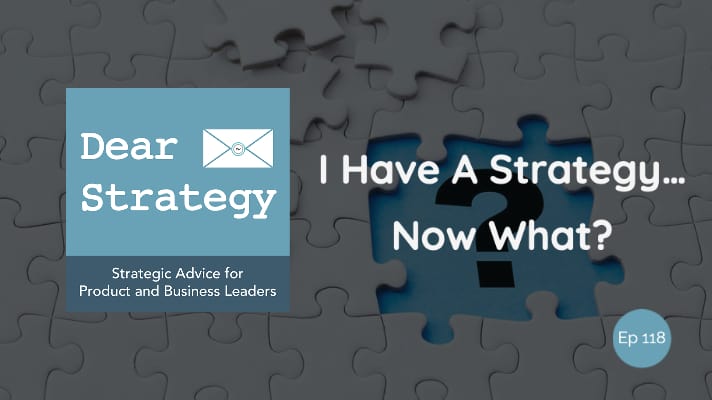On this episode of Dear Strategy, we answer the following question…
Dear Strategy:
“What is the next step once you have a strategy?
It’s been a long time since I wrote a short post. It’s not that I don’t normally intend to; it’s just that, apparently, I have so much to say! But, if ever there was a candidate for a post on the shorter side of things, this is it. So, let’s give it a go…
The most obvious answer to this question is that the next step after creating your strategy is to simply go out and execute upon it. But that’s just a little bit too short of an answer! So let’s break it down into 3 different parts:
Part 1 of the execution phase is to make sure that you’ve thoroughly laid out your expected investments. We’ve actually covered this quite a bit in the last few posts, so be sure to go back and have a look at Episode 114 and Episode 116 for more information on exactly how you can do that. But the bottom line is, no strategy is going to be free. So, once you have your plan, it’s imperative that you lay out exactly what resources you’re going to need to make that plan happen, and then determine how much those resources are going to cost.
Part 2 of the execution phase is to clearly outline your anticipated results. This is a bit different than outlining your goals and objectives, which tend to be stated at specific points in time. Your anticipated results, on the other hand, are intended to illustrate what your strategy is expected to deliver back to your business on a year-to-year basis. The reason for doing this, by the way, is to validate the return on your investments and, ultimately, get approval to move forward with your strategy from whoever is going to be financing it. Whether it’s a group of outside investors, an executive leadership team, or even just yourself as a solo entrepreneur; whoever is putting up the money is going to want to know what they’ll be getting in return. So you need to have all of that laid out as plainly and as simply as you possibly can.
Part 3 of the execution phase is to go make everything in your plan a reality! That means lining up your resources, communicating your strategy, and driving your actions in pursuit of your strategic goals. A lot of this is going to hinge on your effectiveness as a leader, which is why, at Strategy Generation Company, we have a Leadership Skills Workshop specifically designed with strategic execution in mind. But, leaving that cheap attempt at a plug aside, one thing that separates strategic leaders from all other types of leaders is their ability to think (and lead) in a dynamic rather than a linear fashion. That’s essentially what we teach in our course, but what exactly does it mean?
“One thing that separates strategic leaders from all other types of leaders is their ability to think (and lead) in a dynamic rather than a linear fashion.”
Anyone who has followed my work for any period of time probably knows that I have something of a split personality (at least as far as business goes). On the one side, I am an engineer’s engineer – meaning that I like everything to have a place, an answer, and a logical fit. On the other side, I’m a musician and a composer – meaning that I understand how to take a standard set of patterns and work them into forms and structures that don’t always make sense. It is this mix of linear and dynamic thinking that I believe draws me so passionately into the world of strategy development – because it is this exact mix that, at least in my experience, makes for the most successful strategic plans.
When I developed the Strategy Generation Framework that I use in my courses and workshops, I very consciously took an otherwise sequential process and illustrated it in an entirely circular and dynamic form. And that is exactly how I would sum up the entire strategy process – you’ll develop it in steps, and then you’ll execute and revise it in circles. Conditions will change, assumptions will be revisited, goals and actions will be dynamically modified – and all of that will happen in no particular order and at no particular time. The best you can do is to know where all those revisions should be plugged back into your plan, and then keep repeating the process over and over again until you achieve your goals.
That’s what strategic leadership is really all about. And developing that skill, in a nutshell, is truly the next step once you have a strategy.
Listen to the podcast episode
Dear Strategy: Episode 118

Are you interested in strategy workshops for your product managers or business leaders? If so, please be sure to visit Strategy Generation Company by clicking the link below:
 Bob Caporale is the founder of Strategy Generation Company, the author of Creative Strategy Generation and the host of the Dear Strategy podcast. You can learn more about his work by visiting bobcaporale.com.
Bob Caporale is the founder of Strategy Generation Company, the author of Creative Strategy Generation and the host of the Dear Strategy podcast. You can learn more about his work by visiting bobcaporale.com.







